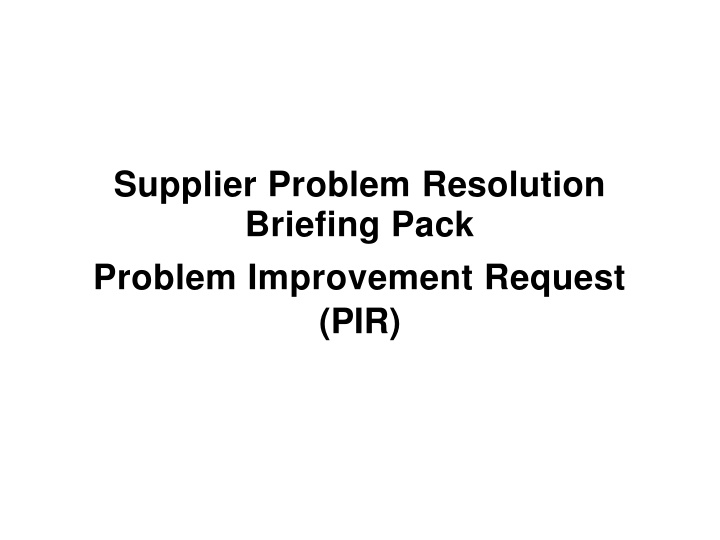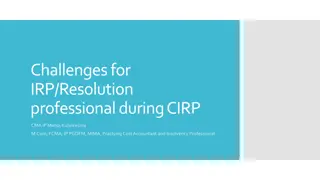Supplier Problem Resolution Briefing Pack - Problem Improvement Request (PIR)
The Problem Improvement Request (PIR) process is essential for addressing non-conformances, quality escapes, customer complaints, delivery issues, and product rejections. It focuses on identifying root causes, implementing corrective actions, and preventing future recurrences. Suppliers are encouraged to view PIR as a proactive tool for driving continuous improvement and enhancing overall business processes.
Download Presentation

Please find below an Image/Link to download the presentation.
The content on the website is provided AS IS for your information and personal use only. It may not be sold, licensed, or shared on other websites without obtaining consent from the author.If you encounter any issues during the download, it is possible that the publisher has removed the file from their server.
You are allowed to download the files provided on this website for personal or commercial use, subject to the condition that they are used lawfully. All files are the property of their respective owners.
The content on the website is provided AS IS for your information and personal use only. It may not be sold, licensed, or shared on other websites without obtaining consent from the author.
E N D
Presentation Transcript
Supplier Problem Resolution Briefing Pack Problem Improvement Request (PIR)
Problem Improvement Request Introduction: For all Concessions, Quality Escapes, Customer Complaints, delivery issues or product rejections, effective completion of the PIR is a pre-requisite of the Non- conformance Process. The PIR process will identify products and processes that can be exposed to similar non-conformance, which can be addressed via "read across" action. Key Questions: Has the Problem been effectively contained, and by what means? Does the PIR and actions detailed actually address the root cause(s) of escape and problem? Are the stated actions plausible and the true root cause(s) of the escape and problem? Is there sufficient detail and supporting data to underwrite the cause(s)? Is there objective evidence to demonstrate that a thorough process has been followed to establish why (e.g. 5 - Why's, Cause & Effect Diagram etc.)?
Problem Improvement Request Continued: Having established the root cause, we customers expect robust and demonstrable corrective action: Are the actions identified meaningful and accurate? Is the implementation of corrective actions scheduled to be achieved over a realistic timescale, relative to the severity of the original problem and it's affect on the customer Are all corrective actions in place / complete, verifiable and by what means?
Problem Improvement Request Our perspective : The PIR Process is structured to enable suppliers to investigate non-compliance within their systems and return them to a compliant state. Suppliers should be using the tool not only to facilitate the acceptance of non- conformance but also as a vehicle to eliminate any future recurrence and protect the customer. The PIR is / should not be viewed as an afterthought, nor should it be seen as a burden. The supplier has ownership of the document and all associated actions identified / detailed therein - that owner has the ability to both identify and drive change, or process improvement - as appropriate.
Problem Improvement Request The suppliers perspective should be : The PIR is the tool that will be used to improve the business and drive down the cost of non-quality. There is an on-going commitment to improve the business and eliminate unnecessary waste. In the case of non-conformance, use of the PIR is a critical part of that process to ensure the Escape & Problem will not re-occur and not just a short term vehicle raised to re- commence deliveries. There should be an on-going review of all PIR's raised to assist in monitoring overall process compliance - not just at the next concession arising! The PIR can be used to support / justify investment in the process.























